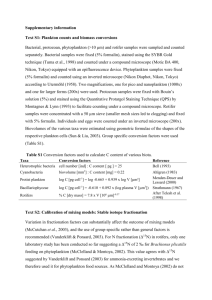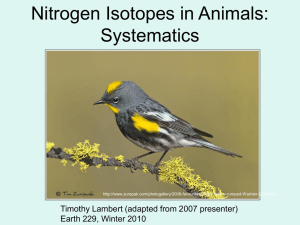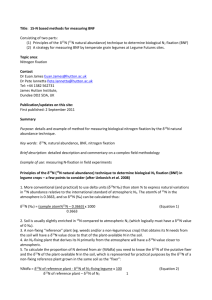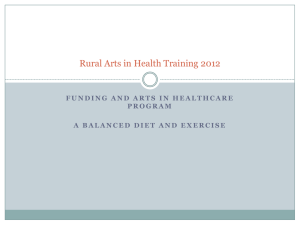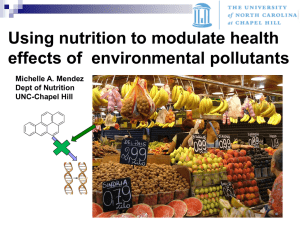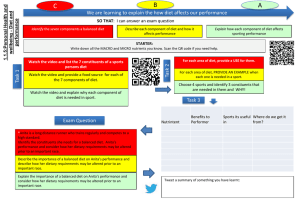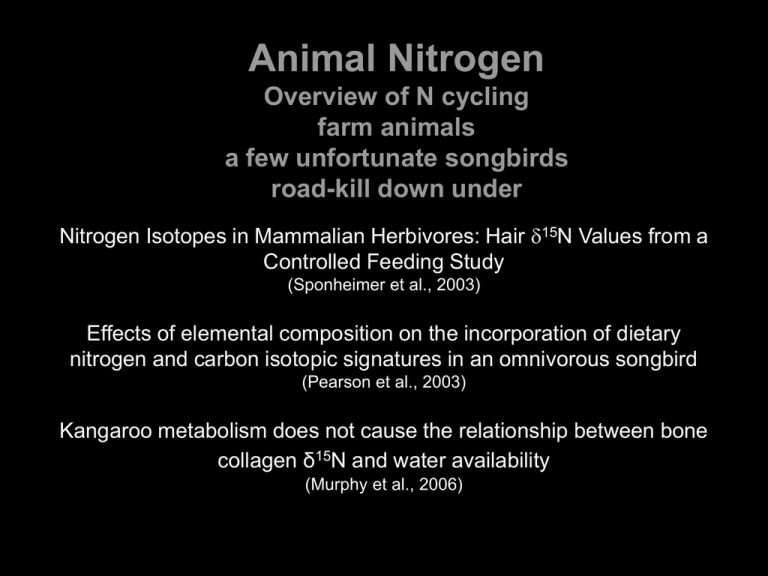
Animal Nitrogen
Overview of N cycling
farm animals
a few unfortunate songbirds
road-kill down under
Nitrogen Isotopes in Mammalian Herbivores: Hair 15N Values from a
Controlled Feeding Study
(Sponheimer et al., 2003)
Effects of elemental composition on the incorporation of dietary
nitrogen and carbon isotopic signatures in an omnivorous songbird
(Pearson et al., 2003)
Kangaroo metabolism does not cause the relationship between bone
collagen δ15N and water availability
(Murphy et al., 2006)
N Cycle
(human)
protein turnover
•Some proteins
turnover faster than
others
•some tagged
(oxidized or other
means)
amino acid pool
•throughout body
•significant
mixing
N Cycle
(human)
Dietary protein
•Low
•deficiency of
essential aa’s
•High
conversion to
fat/glucose
Ammonia/urea
excretion
Deamination
First transfer amine group to carrier
Ketoglutarate
→
Glutamate
in liver or kidney
Then deaminate Glutamate
to produce ammonia
Synthesis
First transfer amine group to carrier
Then to amino acid
in liver or kidney
Ketoglutarate
→
Glutamate
Deamination
Synthesis
*Direction of these reactions controlled by [ ] of
Glutamate
Ketoglutarate
Ammonia
ratio of oxidized to reduced enzymes
Urea cycle
kidney
liver
Urea cycle controlled by acetyl CoA
and glutamate
increase in [ ] after protein rich meal
Nitrogen excretion animals
Ammonia NH3
•Simplest form, but toxic
•fully aquatic animals
Urea (NH2)2CO
•Still toxic more complex than ammonia
•mammals some herps (frogs),
cartilaginous fish
Uric Acid C5H4N4O3
•Least toxic
•egg layers (bird, reptiles, insects)
•precipitates from egg
A few things
1.
2.
3.
4.
5.
animals assimilate dietary components with varying
efficiencies
animal tissues fractionate the isotopes in their diet
animals allocate nutrients in their diet differentially to
specific tissues ‘isotopic routing’
animals retain δ15N, excreting δ14N (~6‰)
protein balance is a key to fractionation
low dietary protein = “protein sparing” reserve dietary protein
for tissue maintenance rather than catabolizing it for energy
(Castellini and Rea 1992).
high dietary protein = use diet protein for tissue synthesis and
catabolize excess
Nitrogen Isotopes in Mammalian Herbivores: Hair
15N Values from a Controlled Feeding Study
(Sponheimer et al., 2003)
Goals:
Determine the importance of
1. hindgut vs foregut fermentors
2. dietary protein levels
on herbivore δ15N values.
Nitrogen uptake herbivores
Hindgut
•
•
Horses, rabbits, birds, iguanas, green turtle
Limited cycling of urea nitrogen
fermentation, N cycling, protein balance
Foregut
Ruminants (can synthesize proteins from inorganic nitrogen
compounds)
• multi compartmental stomachs
• cows, llamas
Ruminant-like
• kangaroos, wallabies, hoatzin
cycle/mix N from diet and self
deamination and de novo protein syntheses
Diet-Hair Fractionation
Same diet, fair bit of variation
rabbits and alpaca vary 3.6‰, > 1 trophic level!
Foregut fermenters are enriched vs hindgut fermenting rabbits
But not to horses…
High Protein vs Low Protein Herbivores
↑ dietary protein (9-19%)
causes enrichment δ15N (1.52.8‰)
Not what they expected!
This refutes N cycling hypo
(states that low protein
group ↑δ15N)
feces explanation poor
feces is δ15N enriched (0.53.0‰), low protein = less
urine loss and greater
relative (not absolute) %N
loss via feces, ↑δ15N loss
Effects of elemental composition on the incorporation
of dietary nitrogen and carbon isotopic signatures in
an omnivorous songbird.
(Pearson et al., 2003)
Goals
•Determine turnover rates of δ15N and
δ13C in whole blood and plasma.
yellow-rumped warbler
•δ15N and δ13C diet-tissue fractionation factors for plasma,
whole blood, and feathers.
•Influence of high protein (%N) and low protein (%C)
concentrations on fractionation factors.
Materials and methods
•32 captive wild-caught migratory birds
•‘controlled’ for age & sex
•Acclimation diet 32% insect
•Experimental diet
20%,49%,73%, 97% insects
•Sampled
•21 days, mass, blood (plasma, wb), feathers (entire)
•Determined
•C&N δ values of different diets
•turnover rates
•Discrimination
•Isotopic signatures of diet on different tissues
Diets: %Insect, Isotopes, &
Concentrations
Attempted to created diets along a linear continuum of increasing
a) isotopic signature (didn’t quite work for 15N)
b) elemental concentration
by increasing the % insect protein in diet
Diets: %Insect, Isotopes, &
Concentrations
Only 0.12‰ difference in δ15N values among diets.
Diet containing most insects did not have highest δ15N value
(diet with lowest proportion of insects did not have the lowest δ15N value)
Banana Effect (δ15N 0.5 - 5.3‰)
Turnover Rates
Isotope incorporation kinetics model
(O’Brien et. Al 2000)
Δdt = discrimination factor
r = fractional turnover rate
Half-life =
Turnover Rates: Half-life Plasma & Blood
Half-life estimates plasma: δ13C 0.4-0.7 days
Half-life whole blood:
Whole blood is variable!
δ13C ~4-6 days (diet 1=33 days!)
δ15N: 0.5-1.7 days
δ15N 7.45-27.7 days
Discrimination: Plasma, Feather, and Blood
15N values plasma & whole blood
enriched 1.7 to 3.0‰
“Apparent” fractionation factor for
feathers
15N enriched (3.2-3.6‰)
Fractionation factors
increased linearly with
elemental concentration
in diet for N
↑ %N
in
↑ tissue
δ15N
out
↑ urine w/ ↑ 14N
Importance of Elemental Concentrations
Both isotopic signature of diet and fractionation factors influence
the ultimate isotopic signature of tissues (at least plasma).
Supports the importance of using concentration-dependent
mixing models when reconstructing diet.
Results
•Discrimination factors depend on diet and tissue
•Fractionation factors to reconstruct diet requires an
estimate of elemental concentrations in the diet.
•Turnover rates
Plasma 1 day (short)
Whole blood 1 wk (longer)
• Carbon and nitrogen fractionation factors increase
linearly with elemental concentration in the diet.
• Relationship between the isotopic signature of the diet
and the sum of a given tissue’s (at least plasma) isotopic
signature + fractionation factor was also positive & linear.
USE CONCENTRATION-DEPENDENT MIXING MODELS WHEN
ATTEMPTING TO ESTIMATE THE RELATIVE CONTRIBUTION OF
DIFFERENT FOOD SOURCES TO AN ANIMAL’S DIET!!!
Kangaroo metabolism does not cause the
relationship between bone collagen δ15N and water
availability
Goals
(Murphy & Bowman, 2006)
• Evaluate importance of water availability and dietary δ15N
in determining δ15N values in herbivore bone collagen
• Indirectly determine if ↑ δ15N linked to animal metabolism
• Assessed if δ15N in grass and Kangaroo bone collagen
are constant with respect to a Water Availability Index
• Examine other factors influencing
δ15N in herbivore bone collagen
Does ↓ Water availability
↑ δ15N in Animal Tissue?
Plants enriched in arid environs
• ‘openness’ N cycle theory (Austin & Vitousek 1998)
– ↑ water in system = ↓ in ratio of N loss to intrasystem N turnover
• Cryptobiotic crusts
Why ↑ animal δ15N when in water limited systems?
•
Metabolic enrichment ‘theories’
– ↑ Urea osmolarity, urine excreted is more nitrogen (δ15N)
concentrated (Ambrose & Deniro 1986, Sealy 1987)
• excrete more δ15N deplete urea when arid (Sponheimer 2003)
• not experimentally shown for rats (Ambrose 2000)
– not tested rigorously…
BUT… can ↑ δ15N be explained by herbivore diet alone?
Methods
• 173 grass collections (3-4 primary
spp/collection)
• 779 road killed roos
– macropus sp, grazers…
• Water Availability Index estimated
from mean annual actual and
potential evapotranspiration
• Akaike’s Information Criterion (AIC)
Big study!
→
+
+
=
data
Results
Found relationship of δ15N
and WAI similar between
grass and kangaroo bone
collagen
4.74‰ to 4.79 ‰ enrichment
~0.05‰ variation over entire
range of data
When plotted against annual
rainfall Murphy & Bowman’s
δ15N relationship fits with
•Previous Kangaroo work
•Eutherian herbivores
North America & Africa
matches
Sealey et al 1987 follows
similar pattern
What about C3 vs C4 grasses?
•δ13C of bone collagen as proxy
•negative and weak relationship
•Found lower δ15N in C4
plants (1.1‰)
•C4 diet (high δ13C, low
protein) = lower consumer
δ15N
Model gave little support
for other variables:
•slope
•chenopod
C3
C4
C3
C4
Summary
• Strong negative relationship of herbivore δ15N bone
collagen and water availability.
• Near identical negative pattern of δ15N in grass and
kangaroo bone collagen with water availability (near
constant offset in slopes)
• Suggest dietary δ15N is main cause of negative
relationship between δ15N of kangaroo bone
collagen, with water availability and metabolic factors
having little discernible effect.
Importance…
• Ties water availability directly to plant δ15N to animal
δ15N values, with little ‘animal’ affect
• Huge support for historic trophic ecology and past
climate change data that rely on direct relationship
between herbivores and plants which not confounded
by animal metabolism
Marine food webs are enriched in δ15N
(Kelly 2000)
Trophic Systems
Marine systems 3-4‰/trophic level
Herbivores ~3.2‰
Carnivores 5‰
(Hobson & Welch 1992)
Trophic Systems
• Marine food chains tend to have longer food
webs
• Diet affects, as ascend trophic chain, ↑ %N in
diet
expect more catabolism = discrimination @ high trophic
level
• Trophic enrichment commonly produces 3:1
slope for δ15N and δ13C ratios
• N15 to get at rainfall abundance
Hair
Diet-Hair d15N Equilibration
Dietary 15N values changed from 2.5‰ to 7.8‰.
Dietary equilibration took ~8-10 weeks
Kelly
δ15N in top consumers in C3, C4 and
Marine food chains
(Kelly 2000)
Discrimination
• Tissue effects
Feathers more enriched than plasma or wb
Diet Tissue Relationship
• C & N signatures linearly related with tissue
signatures + discrimination factors
Turnover Rates
• Correlated linearly with metabolic rate of tissue
• Different species have different turnover rates
for same tissues
Likely related to size, mass specific metabolic rates,
life history factors
half-life for wb C in bear > crow > quail > warbler
Turnover Rates
•
•
•
•
Plasma (1-5 days)
Whole Blood (5-35 days)
Feces (
Feathers, Hair, Nails, Hoof (time when grown,
maybe a lag here)
• Bone
• Teeth
Importance of Elemental
Concentrations
Phillips & Koch 2002
Implications
CO2
WUE
NPP
‘openness’ of N cycle
δ15N in plants
δ15N in herbivores
N demand
• Pearson
• Funk/questions
- variability in initial mass and mass change
following dietary switch among treatment
groups (shows they like carbs
- Diets did not have ↑ δ15N values w/
↑ % insects
- Fractionation vs. discrimination
CO2 effects on δ15N
(Coltrain et. Al. 2004)

